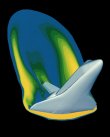
This is a computational fluid dynamics computer-generated Space Shuttle
model. DFC has supplanted wind tunnels for many evaluations of aircraft.
As computing power increases and computer models become more sophisticated,
CFD will largely replace wind tunnels.
|
Fluid
Mechanics and Fluid Dynamics
Fluid
mechanics is one of the oldest and broadest fields of engineering. It
deals with the properties and behavior of fluids, i.e., liquids and gases
at rest (fluid statics) or in motion (fluid dynamics). Because of their
ability to flow, liquids and gases have many properties in common not
shared by solids. The study of fluids in motion, or fluid dynamics, makes
up the larger part of fluid mechanics. Branches of fluid dynamics include
hydrodynamics (study of liquids in motion) and aerodynamics (study of
gases in motion) as well as vortex dynamics, gas dynamics, computational
fluid dynamics (CFD), convection heat transfer, flows of turbo machinery,
acoustics, bio-fluids, physical oceanography, atmospheric dynamics, wind
engineering, and the dynamics of two-phase flows. Modern design of aircraft,
spacecraft, automobiles, ships, land and marine structures, power and
propulsion systems, or heat exchangers relies on a clear understanding
of the relevant fluid mechanics.
CFD
is a computational technology that enables the user to study the dynamics
of things that flow. Using CFD, a computational model is built that represents
the system or device being studied. Then, the fluid flow physics is applied
to this virtual model, and the software generates a prediction of the
flow about or inside the body being studied. With correct numerical simulation
of the flow field, fluid forces and movements can be calculated and used
for practical engineering purposes such as aircraft design.
CFD
uses high-speed computers and numerical methods to seek approximate solutions
to the mathematical equations that describe fluid flow. It allows designers
to predict quantitatively what will happen when fluids flow and has, to
some extent, replaced the use of wind tunnels for modeling of the behavior
of fluids. Such an approach is useful because the complexity of fluid
motion and its governing mathematical equations often defy more traditional
techniques.
|



